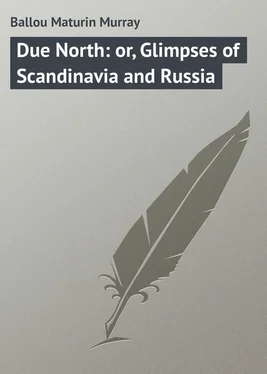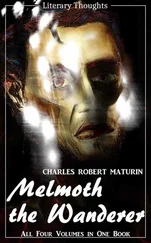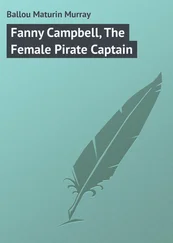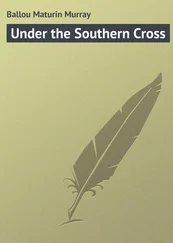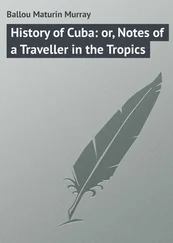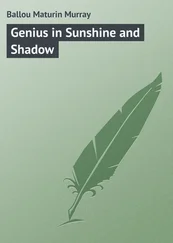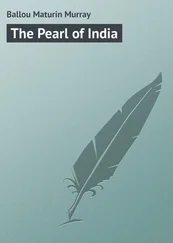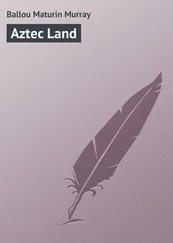Maturin Ballou - Due North - or, Glimpses of Scandinavia and Russia
Здесь есть возможность читать онлайн «Maturin Ballou - Due North - or, Glimpses of Scandinavia and Russia» — ознакомительный отрывок электронной книги совершенно бесплатно, а после прочтения отрывка купить полную версию. В некоторых случаях можно слушать аудио, скачать через торрент в формате fb2 и присутствует краткое содержание. Жанр: foreign_prose, Путешествия и география, на английском языке. Описание произведения, (предисловие) а так же отзывы посетителей доступны на портале библиотеки ЛибКат.
- Название:Due North: or, Glimpses of Scandinavia and Russia
- Автор:
- Жанр:
- Год:неизвестен
- ISBN:нет данных
- Рейтинг книги:3 / 5. Голосов: 1
-
Избранное:Добавить в избранное
- Отзывы:
-
Ваша оценка:
- 60
- 1
- 2
- 3
- 4
- 5
Due North: or, Glimpses of Scandinavia and Russia: краткое содержание, описание и аннотация
Предлагаем к чтению аннотацию, описание, краткое содержание или предисловие (зависит от того, что написал сам автор книги «Due North: or, Glimpses of Scandinavia and Russia»). Если вы не нашли необходимую информацию о книге — напишите в комментариях, мы постараемся отыскать её.
Due North: or, Glimpses of Scandinavia and Russia — читать онлайн ознакомительный отрывок
Ниже представлен текст книги, разбитый по страницам. Система сохранения места последней прочитанной страницы, позволяет с удобством читать онлайн бесплатно книгу «Due North: or, Glimpses of Scandinavia and Russia», без необходимости каждый раз заново искать на чём Вы остановились. Поставьте закладку, и сможете в любой момент перейти на страницу, на которой закончили чтение.
Интервал:
Закладка:
Copenhagen is liberally supplied with free hospitals and charitable institutions, but except the Communal Hospital, the buildings devoted to these purposes have no architectural merit. A child's home was pointed out to us designed for the children of the poor, whose parents are unable to take care of them during their working hours. Before going out to a day's labor, a mother can place her child in this temporary home, where it will be properly cared for and fed until she returns for it. "Is any charge made for this service?" we asked. "Certainly," replied our informant, himself an official of importance; and he named a sum equal to about five cents of our money as the price per day for the care of each infant. "If it were entirely gratuitous," he added, "it would not be nearly so well appreciated, and would lead to imposition. The payment of this trifling sum enhances the estimate of the privilege far beyond its cost." The institution could not be sustained by such limited charges however; its real support is by the local government. Another institution was visited, designed for the sick and poor, where they can be properly nursed when temporarily ill, yet not sufficiently so to seek admission to a regular hospital. There have been as many as eight thousand patients admitted within a twelve-month to this establishment. There are also homes for old men and old women, intended for indigent persons who are too old to work. From the latter "home" there was observed driving upon the Lange Linie, beside the sea, a large open wagon full of dames who were enjoying a healthful outing. As the vehicle passed us, the driver was pointing out to his charges the distant view of Sweden, across the intervening Sound. The Royal Theatre or Opera House, situated on the King's Square, was to us a surprise, – it is so similar, at first sight, to the more elaborate and costly Opera House in the Place de l'Opéra in Paris, and as it antedates that elegant structure, it would certainly seem to have suggested some of its best lines. The Danish theatre will accommodate seventeen hundred persons, and is usually well filled, the royal box being seldom empty. The corridors are remarkable for spaciousness, and form a popular promenade for both sexes during the intervals between the acts. This furnishes an agreeable social break to the often long-protracted performances. On one side of the theatre facing the Square is a hideous bronze statue of Adam Oehlenschlaeger, the Danish lyric author; and on the opposite side is another representing Ludwig von Holberg, the Norwegian dramatist. This latter, in an artistic sense, is still more objectionable than the first named. The ballet as represented here is unique, being mostly designed to illustrate the early history of Scandinavia.
On one of the main thoroughfares leading from the Square already named, the triple domes of a Russian church dazzle the eye with their bright gilded surface and long hanging chains, depending from cross and crescent of the same metal, the whole reflecting the sun's rays with the force of a Venetian mirror. The interior, however, is plain, though rich in white marble, here and there carved in lattice pattern to form balustrades and dädos. Near by this church is the residence of the Russian Minister. On this same street, called the Bredgade, is the Frederick's Church, begun as long ago as 1749, after a grand design, and not yet finished. It is half surrounded to-day by a broad high staging, upon which groups of mechanics were seen busily at work, as has been the case for so many generations. This is known as the Marble Church, and is surmounted by a grand if not graceful dome of immense proportions. The English residents of the city are building an Episcopal church on the Esplanade, the local government having given the ground for this purpose. The corner-stone was laid by the Prince of Wales in 1885, with a grand ceremony, at which the Emperor and Empress of Russia assisted, with all the Danish royal family. It is the first English church erected in the country. On the Amaliegade, which runs parallel with the Bredgade and which is the next street to it, are four spacious palaces, which form a square, in the centre of which stands a bronze statue of Frederick V. These palaces are the town residence of the present royal family, one being also devoted to the business of the Foreign Office. The Amaliegade ends at the Lange Linie, where the Esplanade begins.
The spire of the large city Exchange is very curious, being formed of the twisted tails of three marvellous dragons, their bulging heads resting on the four corners of the tower, – altogether forming the most ridiculous attempt at architectural ornamentation we have yet chanced to behold. The building thus surmounted dates back to 1624, forming a memento of the reign of Christian IV. The Church of our Saviour has also a remarkable spire, with a winding staircase outside leading to the pinnacle. The bell which surmounts this lofty spire, and upon which stands a colossal figure of our Saviour, is said to be large enough to contain twelve persons at a time; but without climbing to the summit, the local guide's assurance that there were just three hundred and ninety three steps between base and top was unhesitatingly accredited. This church was consecrated in 1696. A peculiarity of its steeple is the fact that the spiral stairs wind upwards in the opposite direction from that which is usual. This was undoubtedly an accident on the part of the mechanics. Christian IV. detected the awkwardness and pointed it out to the architect, who, singular to say, had not before realized a circumstance which is now so obvious. His consequent chagrin was so great as nearly if not quite to render him insane. He ascended the spire on the day when the work was completed, and ended his life by throwing himself from the summit. Such was the entertaining legend rehearsed with great volubility to us by our local guide, who was evidently annoyed at our smile of incredulity.
In strolling about the town one comes now and then upon very quaint old sections, where low red-tiled roofs and houses, with gable ends towards the street, break the monotony. The new quarters of Copenhagen, however, are built up with fine blocks of houses, mostly in the Grecian style of architecture, – palatial residences, with façades perhaps a little too generally decorated by pilasters and floral wreaths, alternating with nymphs and cupids. The two-story horse-cars convey one in about fifteen minutes over a long, level, tree-shaded avenue from the centre of the city to in the environs. It is a palace erected by Frederick IV. as a summer residence for himself and court, but though capacious and finely located, it is void of all aspect of architectural grandeur. As a portion of the grounds commands a fine view of the city, the castle is generally visited by strangers. The spacious building is at present used for a military educational school. The park which surrounds is the great charm of the locality, being ornamented in all parts by immemorial trees, deep sylvan shades, purling streams, graceful lakes, and inviting greensward. It forms the daily resort of picnic parties from the close streets of the town near at hand, who come hither on summer afternoons in such numbers as to tax the full capacity of the tramway. At the entrance to the park stands a bronze statue of Frederick IV., which presents so strong a likeness to Lamartine, in form and feature, as instantly to recall the French orator and poet. Adjoining the extensive grounds of the castle is the Zoölogical Garden, which appears to occupy about ten acres of well-wooded and highly cultivated territory, ornamented with choice flower-beds, small lakes for aquatic birds, and a large brook running through the midst of the grounds. There is here an admirable collection of animals. The author's visit chanced upon a Saturday afternoon, when a bevy of primary-school children, composed of boys and girls under twelve years, was being conducted from section to section by their teachers, while the nature of each animal was lucidly explained to them. No advantage for educational purposes seems to be forgotten or neglected in Denmark.
Читать дальшеИнтервал:
Закладка:
Похожие книги на «Due North: or, Glimpses of Scandinavia and Russia»
Представляем Вашему вниманию похожие книги на «Due North: or, Glimpses of Scandinavia and Russia» списком для выбора. Мы отобрали схожую по названию и смыслу литературу в надежде предоставить читателям больше вариантов отыскать новые, интересные, ещё непрочитанные произведения.
Обсуждение, отзывы о книге «Due North: or, Glimpses of Scandinavia and Russia» и просто собственные мнения читателей. Оставьте ваши комментарии, напишите, что Вы думаете о произведении, его смысле или главных героях. Укажите что конкретно понравилось, а что нет, и почему Вы так считаете.
